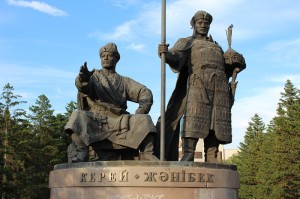Kazakh scientists highlighted a number of recently announced new facts concerning the history of the Kazakh Khanate. Historians have revealed little-known details after precisely studying thousands of archival documents that were stored in various countries in Europe and Asia.
The unique data will be described in scientific papers to be released as part of the celebration programme dedicated to the establishment’s 550th anniversary, KTK television channel reported.
Historian Meruert Abusseitova of the Almaty-based Institite of Oriental Studies found the Kazakh Khanate political hierarchy depicted on the huge carpet showcased in a museum in Bern, Switzerland. Kazakh craftswomen portrayed a scheme showing khan in the centre of the carpet, surrounded by sultans and biys (judges). This image once again proves the fact that Kazakh Khanate had a clear structure of statehood and power system.
Most of the documents investigated, granted by foreign museums for research purposes, embody diplomatic correspondence with neighbours which was conducted in several languages.
“Kazakh khans were able to speak not only the Chagatai language, which is a member of the Turkic language family, but they could also express themselves in Persian. Some of them could also speak the Chinese and Oirat (Dzungar) languages,” said Abusseitova, professor and corresponding member of the Kazakh National Academy of Sciences.
Kazakh khans carried out diplomatic missions by signing various contracts, presenting gifts and joining with other tribes. Close trade and political ties were established with Persia and the Ottoman and Mughal empires. Historians have also been able to learn additional interesting facts about Zhanibek and Kerey khans, the founders of the Kazakh state.
“They both were described as powerful governors. You have to be a strong person in order to separate from an already-existing state and establish your own. Moreover, they did not leave alone. Zhanibek and Kerey inflamed over a million people to go with them and settle in a new state that they planned to create,” explained Abusseitova.
Nurlan Atygaev, Deputy Director of the Institute of History and Ethnology, has also been engaged in the study of state symbols presented for many years by steppe nations. The first Kazakh khans had all-visionary characteristics of power and it was learned that they wore a crown and possessed a throne.
“For example, Kassym Khan [who ruled in 1511-1518], sat on a golden throne; his head was adorned by a crown worth 40,000 tumans (an ancient currency). Such attributes of sovereignty were also presented in the empire of Ghenghis Khan,” said Atygaev.
The Kazakh Khanate united several towns, had its own army, code of laws and currency. Smallcoins known as “tanga”(modern Kazakh currency is called tenge) circulated within the state when it was established.
Throughout its history, the Kazakh Khanate experienced many difficulties and challenges, including decades of wars with Dzungars, before being absorbed by the Russian Empire in the 18th and 19th centuries. In the 20th century, the Kazakh Soviet Socialist Republic existed as one of the constituent parts of the Soviet Union, before becoming a fully independent state of Kazakhstan during the union’s collapse. The country retained its statehood unlike many other medieval khanates, which remain only in the pages of history books about the Asian steppe.


